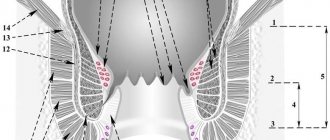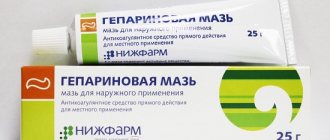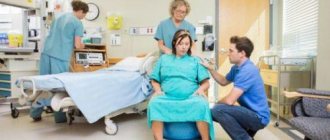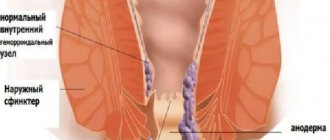Haemorrhoids
- This is a common disease that is associated with an unhealthy lifestyle. Sedentary work, lack of minimal physical activity, stress and eating disorders are all common factors that can provoke the development of hemorrhoidal disease.
Chronic hemorrhoids are a condition that develops over weeks or even months. It is obvious that spontaneous and rapid recovery in this case is almost impossible.
The cause of clinical manifestations of hemorrhoids are dilated cavernous arteriovenous bodies of the rectum. As the disease progresses, they can increase, causing constipation. An increase in intra-abdominal pressure during difficult defecation disrupts the outflow of venous blood from the pelvic veins, resulting in stagnation. This closes a “vicious circle” that maintains the chronic course of the disease and prevents cure.
Don't be ashamed... of hemorrhoids
Even the classics of Soviet satire wrote: “By chewing your food thoroughly, you help society.” To the uninitiated, this statement may seem dubious. But... Food that is not taken in a hurry, on which the teeth and digestive enzymes of the oral cavity have worked hard, is better digested by other parts of the gastrointestinal tract, is better absorbed by the body, and, ultimately, is eliminated from it more simply and easily. Otherwise, digestion time is prolonged, food components stagnate in different parts of the intestine, and constipation occurs. And one of its consequences is hemorrhoids. Many people are very embarrassed about hemorrhoids, although in reality this is not necessary. Hemorrhoids are one of the most common health problems, affecting 8 out of 10 people during their lifetime. Even Napoleon suffered from hemorrhoids. It is said that the insane pain the Emperor experienced contributed to his crushing defeat at Waterloo. But hemorrhoids don't have to be your Waterloo. Of course, for most of us this topic is somewhat sensitive and when we hear the word “hemorrhoids” we begin to blush shyly and look away. So, stop blushing, sit back and read what experts have to say about this common problem.
Where does it come from?
For many years, there was an opinion that hemorrhoids are the same disease as varicose veins of the lower extremities. In fact, there is its own, separate “base”. The basis of hemorrhoids is arterial-venous junctions, which every person has and is not a pathological condition. There are anastomoses between the muscles and the mucous membrane of the anus - three large “pads” inside and outside. Together with the muscles of the anal canal, they hold the intestinal contents. When the process of defecation occurs, the anastomosis “hides” into the muscles, freeing the passage of feces. In addition, anastomoses are special “stations” at which arterial blood mixes with venous blood. Unfortunately, the possibilities of venous outflow are limited, therefore, if the flow of arterial blood increases, “overloads” begin within the “station” itself. Actually, this is hemorrhoids.
Slowly but surely he makes his way
The first stage of hemorrhoids is an enlargement of the hemorrhoids, which is often accompanied by bleeding during bowel movements: prolonged overflow with blood causes stretching of the nodes and thinning of the walls, on which erosions and tears appear. The flowing blood is arterial and scarlet in color. There is also a bloodless option: itching, burning, sensation of a foreign body in the anus. These symptoms do not bother you constantly, but occasionally; Because of this, many patients believe that there is no problem. But chronic hemorrhoids tend to progress without serious treatment. From the beginning to the “advanced” stages it takes approximately 7-10 years. Hemorrhoids are attached to the rectum by muscle fibers. If the nodes “crawl” out, this is already the second stage. Not the worst, because the muscles are still quite functional and easily “pull” the knots inward. Sometimes you can see traces of blood on toilet paper. Here we should be wary, but if there is no pain (or it goes away quickly), our person “moves on with life,” that is, he approaches the third stage, when prolapsed nodes can be adjusted only with his hands. At this stage, nodes can “pop out” even from minimal physical exertion. Doctors believe that in the third stage you need to literally run to the clinic. But they usually run on the fourth, when the muscles finally lose their elasticity and the hemorrhoids can no longer be removed inside - they are on the outside in the form of an inflamed bunch of grapes. At the same time, terrible pain is felt, such that it is impossible to touch even toilet paper.
Clinical manifestations of thrombosis of external hemorrhoids
The main complaints of patients in this category include: the appearance of protrusion (“bumps”) in the anus. The size of these neoplasms can vary and is accompanied by hyperemia and swelling of the surrounding tissues. In most cases, their appearance is accompanied by intense pain. The severity of pain can be determined using special rating scales. The method of further treatment will depend on this assessment. If the number of points is more than seven, then surgical treatment will be required. If up to four points, then you can get by with conservative methods of treating thrombosis of the external hemorrhoid .
thrombosis of the external hemorrhoid
During the act of defecation, a significant increase in pain can be noted, as well as when sitting. The swelling and pain can be unbearable. The severity of the pain will depend on the size of the blood clot. The duration of the disease is on average about two weeks, but may be longer. Also, a blood clot can occasionally be evacuated from a hemorrhoid on its own. And this happens after necrosis of the inflamed area, when the blood clot itself comes out through the area of tissue damaged due to necrosis. At the same time, you will notice a slight discharge of blood. Pain, swelling and the entire inflammatory process will begin to subside after this. But the process of necrosis may not end there, but may move on to the hemorrhoidal node and nearby tissues.
Therefore, in any case, consultation with a specialist is necessary. Even after thrombosis subsides, “fringes” of tissue remain in the affected area, which can cause some discomfort, although they themselves do not pose a threat.
Who can hemorrhoids “attack”?
Previously, it was believed that hemorrhoids were a hereditary disease. However, if we can talk about heredity, it is only in relation to food traditions. Here are the “gastronomic prerequisites for hemorrhoids”: abuse of spicy foods, alcohol, smoking, lack of sufficient plant fiber in the diet. The first two reasons increase the flow of arterial blood, the third - constricts blood vessels, the fourth and fifth contribute to constipation. And constant constipation is one of the most common causes (80%) of exacerbation of hemorrhoids: hard feces severely injure the nodes, disrupting the already damaged blood flow. In addition, heavy lifting and heavy physical activity lead to hemorrhoids. Sedentary work and sedentary leisure are also serious risk factors, because both contribute to stagnation of blood in the pelvis and disrupt the supply of oxygen to the walls of the venous vessels. Hemorrhoids rarely occur among villagers, which is helped by reasonable physical activity, a healthy diet and the lack of fashion for any health-improving and weight-loss diets. But during pregnancy, city women and village women are equal: during this period, the rectum is forced to press against the pelvis, due to which the venous vessels are compressed. Additional stress on the nodes is pushing during childbirth. Hemorrhoids can also be a complication of diseases such as cirrhosis of the liver, prostate adenoma or uterine tumor.
Give life without hemorrhoids!
Hemorrhoids have a direct bearing on quality of life. When the anus - in the figurative expression of surgeons - is “full of bad teeth,” such a life can hardly be called high-quality. With proper treatment, hemorrhoids disappear within a week. Don't be afraid to go to the doctor with severe pain. Firstly, during the examination you will definitely be given anesthesia. Secondly, the doctor will definitely tell you the appropriate painkiller - tablets, ointments or suppositories. Our Center has everything necessary for a comprehensive examination and treatment of many proctological diseases, including hemorrhoids. To treat this “insidious” disease, both surgical treatment methods followed by the patient’s hospital stay, and radical minimally invasive techniques are used. The latter are good because they are highly effective in the treatment of internal hemorrhoids, they rarely cause complications, are well tolerated by patients, and do not require general anesthesia or hospitalization. In principle, in most cases, they are an alternative to the surgical method.
Methods for treating acute thrombosis of external hemorrhoids
Surgical treatment and its benefits
of operations for thrombosis of the external hemorrhoidal node and they involve either removing the entire node or removing the blood clot. The first operation is called hemorrhoidectomy, and the second is called thrombectomy. In this case, both surgical interventions are equally effective. Elimination of the pain syndrome finally occurs on the second or third day after surgery. But it should be noted that after eliminating only the blood clot, there is a high probability of relapse of the disease.
How to treat thrombosis of external hemorrhoids
Conservative treatment
How to treat thrombosis of external hemorrhoids ? These treatment methods are aimed at relieving pain, relieving swelling and inflammation, and normalizing the act of defecation. Today in the pharmacy we can find many effective drugs with different effects (suppositories for hemorrhoids, ointments, tablets). Topical medications can often reduce pain and relieve inflammation. Drugs with an anticoagulant effect have a short-term effect and after their withdrawal the risk of thrombosis reappears. Treatment of thrombosis of the external hemorrhoidal node, drug treatment also helps reduce pain and help normalize blood circulation in the pelvis. It should be noted that only a doctor can prescribe drugs and a conservative treatment regimen, and each drug is prescribed individually in a particular clinical situation. Depending on the individual characteristics of the body and the clinical situation itself.
Full treatment!
In addition to the above, electrocoagulation, cryodestruction, and removal of nodes by radiosurgical methods are also used. Combination treatment is often used - it all depends on the condition of the hemorrhoids. In general, there are many ways. So do not self-medicate and calmly go to the doctor. In addition, in the office of the CELT proctologist, diseases of the rectum, perineum and anal canal are treated: anal fissures, rectal fistulas, benign tumors of the anal canal, anal condylomas, epithelial coccygeal tract (coccyx cysts), inflammation of the rectum and sigmoid colon (proctitis, proctosigmoiditis), etc. CELT proctologists also remove warts, papillomas and perform other cosmetic procedures in the anus using radiosurgery. Unlike those who treat only non-surgically, we do not refer patients to other specialized hospitals. If a person comes to our clinic, he will receive the necessary treatment, for this we have the entire arsenal of tools and techniques.
What are the distinctive features of thrombosis of the external hemorrhoid?
To diagnose a pathology, first of all, it is necessary to conduct an examination, interview the patient, and collect an anamnesis of the disease. During the examination, a purple node is visualized outside the anus, possibly with areas of necrosis. By palpation in the first days of the development of the disease, the presence of a blood clot in the node can be detected, then it splits and the tissues become denser, replacing it.
First of all, thrombosis of the external hemorrhoid should be differentiated from strangulation of the internal hemorrhoid, which has fallen out. The node, which anatomically should be located inside the anal canal, falls out, the leg of the node is compressed, ischemia occurs (insufficient blood supply), and the node itself becomes necrotic. It will be difficult for the patient to understand this. You will need the help of a specialist. It is very important to distinguish between pathologies, since the tactics of treating hemorrhoids and thrombosis of the external hemorrhoid . For example, if a strangulation occurs, emergency surgery is required.
treatment of thrombosis of external hemorrhoids
When an anal fissure occurs, the symptoms of the disease are similar to thrombosis, but are more pronounced during the act of defecation. The pain intensifies significantly. In the case of this disease, the mucous membrane of the anal tissues ruptures. Healing of such a wound is difficult due to the contractile function of the sphincter. In this case, there can be both conservative and surgical treatment of thrombosis of the external hemorrhoid .
Also similar to this disease is acute paraproctitis, which is characterized by the appearance of a tumor-like formation near the anus and unbearably severe pain. Paraproctitis is a focus of inflammation with the appearance of an abscess in the pararectal area. In this case, the pain syndrome is accompanied by an increase in temperature and symptoms of intoxication. Education with paraproctitis is much more painful and larger in volume than with thrombosis. In this case, there is a discharge of pus on the skin or into the intestinal lumen. For diagnostic purposes, an ultrasound examination is performed. If hemorrhoids are not treated in a timely manner, thrombosis of the external hemorrhoidal node may lead to the formation of fistulous purulent tracts in the perianal area.











